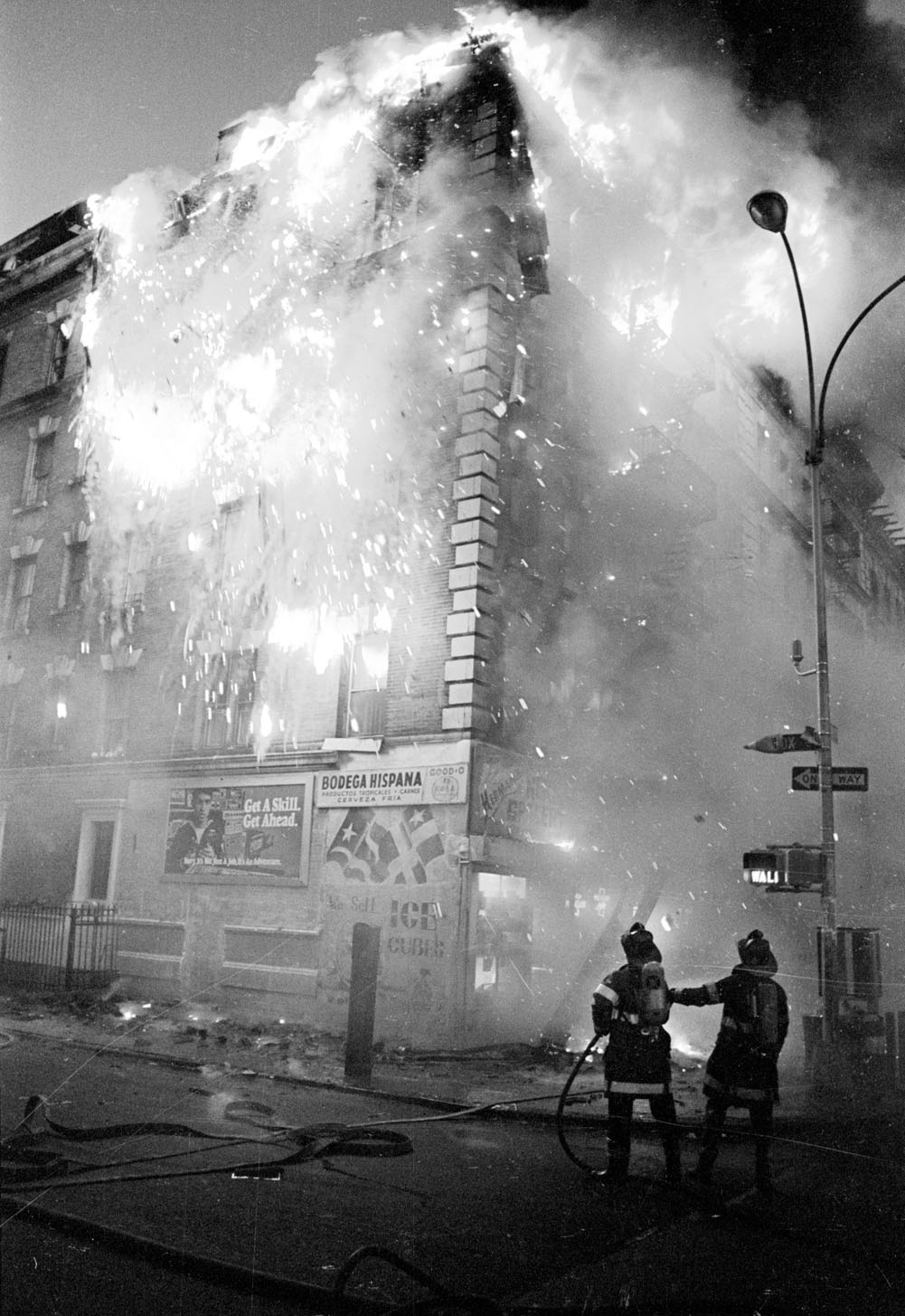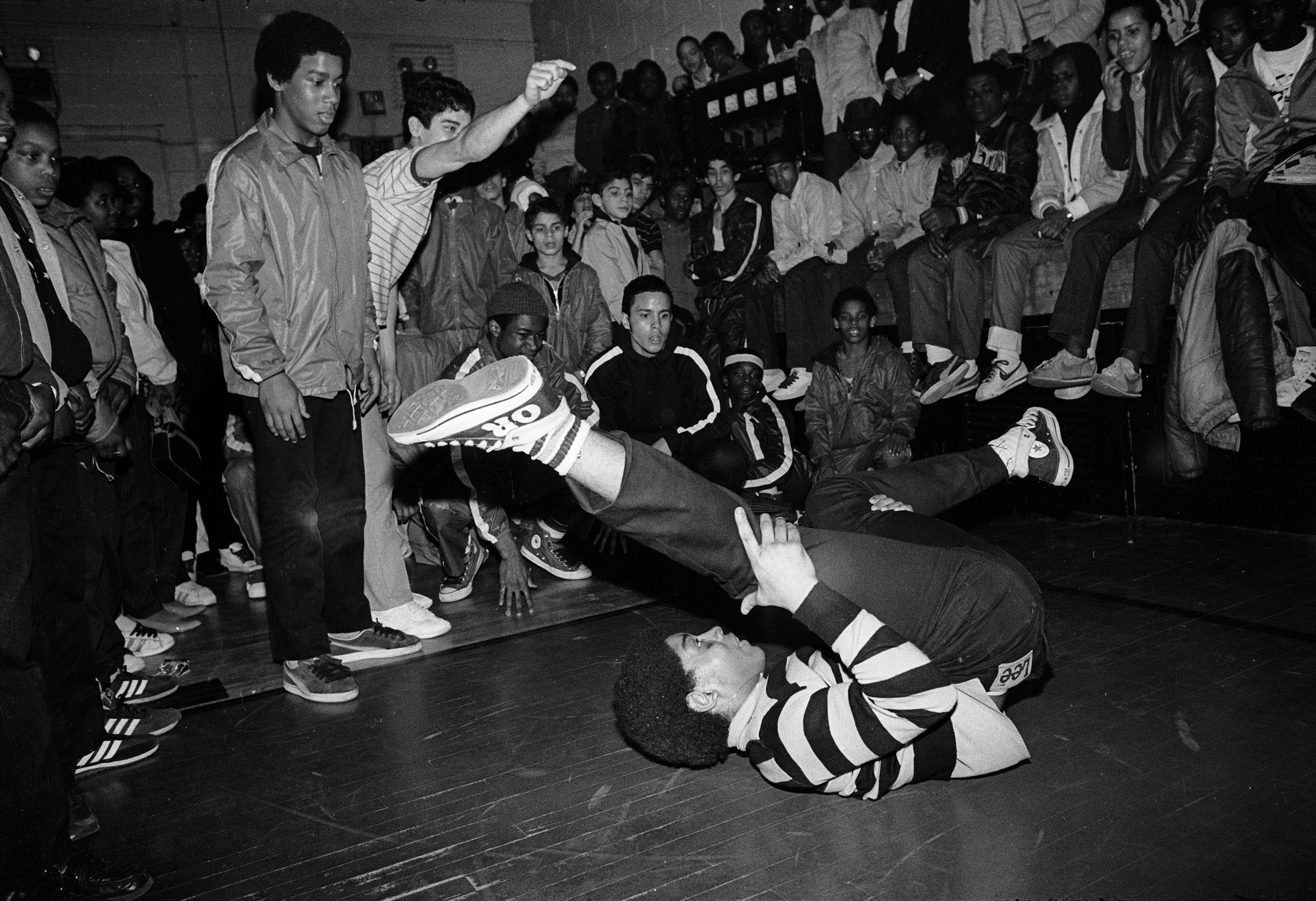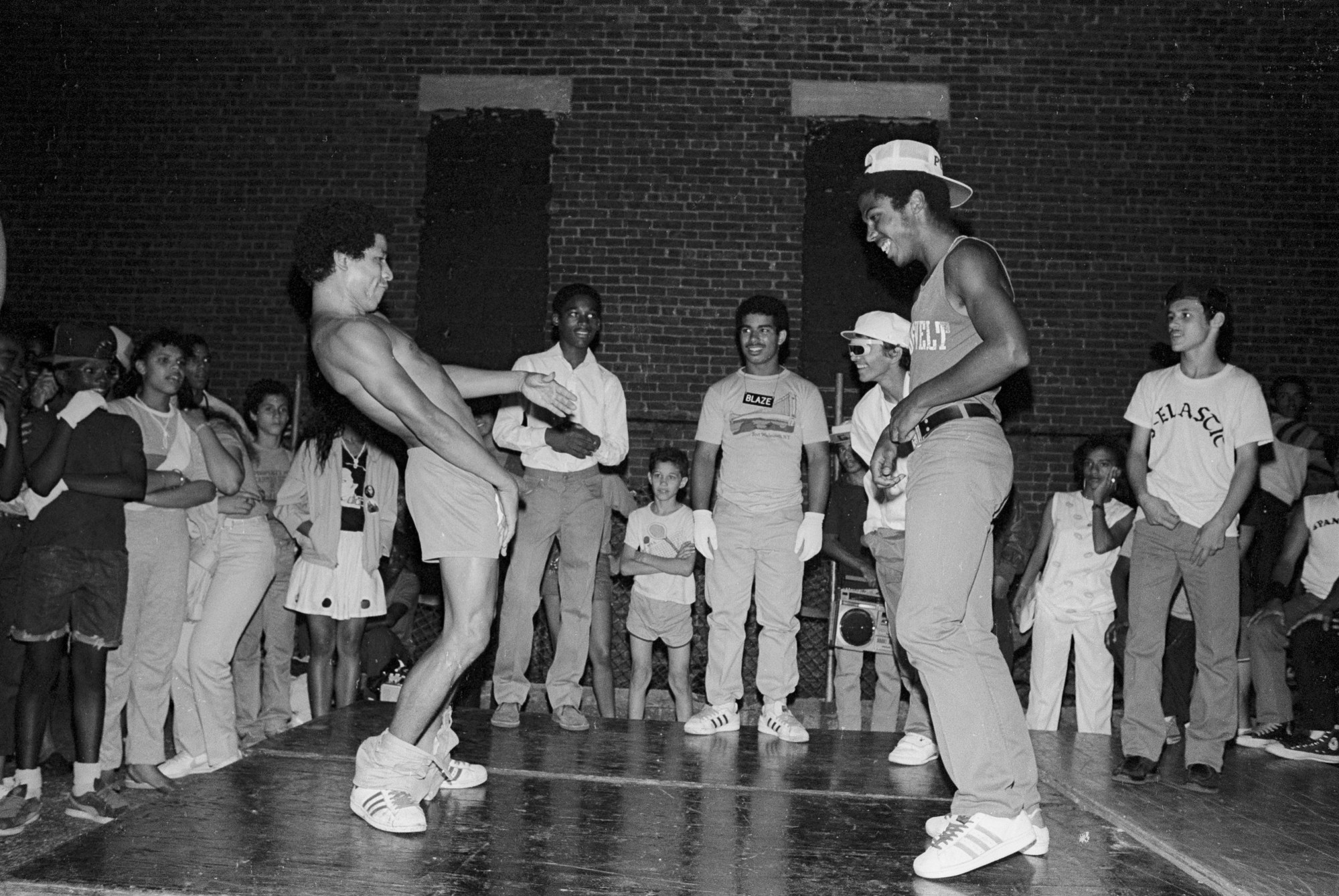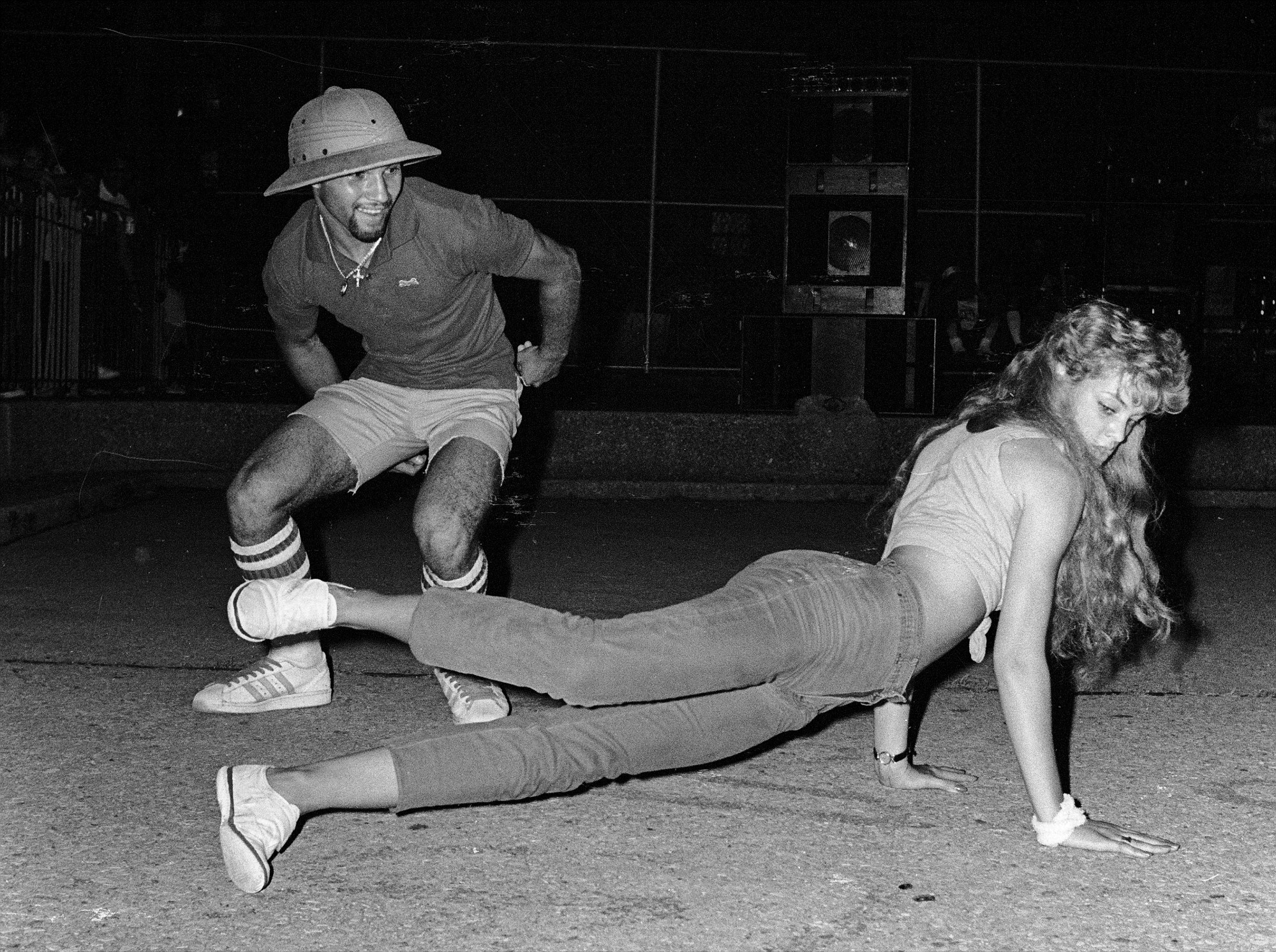The first rule of b-boying is that it is not called breakdancing. Most b-boys consider the term “breakdancing” to be an obsolete one, invented by the white media as an umbrella term, which conveniently packaged together a number of street dances into a unified, nonthreatening spectacle. Breaking’s explosion into mainstream culture robbed it of its historical, social and political context, turning it into a frivolous form of “urban” expression.
Today, those distracted by awe-inspiring head spins are likely unaware of the integral role b-boys and the b-boying subculture played in the creation and development of hip hop culture at large. Breaking was one of the five foundational pillars of the movement that emerged from the Bronx in the 70s, when the neighborhood was subject to extreme urban decay. As property values crashed, over 40% of the South Bronx was burned (by landlords for their insurance value) or abandoned between 1970 and 1980. Breaking, along with DJing, Mcing and “writing” (graffiti), rose from the ashes.
“It’s a story about art and human beings’ resilience, and their ability to use art as a tool to rebuild themselves and create beautiful things out of tragic situations,” says Bronx native Ricky Flores, the celebrated street photographer and who captured the spirit of the nascent b-boy subculture.

“Some say hip hop some begins with the DJ. But actually hip hop culture itself begins with the b-boy. We’re the x factor,” says first generation b-boy Cholly Rock aka Anthony Horne. He traces breaking back to the 60s, when Latinos across New York started “rocking” or “uprocking,” setting mambo-inspired moves to the latest rock and soul hits. Rocking was inspired by battle dances and performed like a showdown. Those who honed in on its more aggressive components called these elaborate dance-disses “burning.” The provocative style became popular amongst feuding New York City gangs, and took hold in one borough in particular: the Bronx.
“B-boying, the way we were doing it, was at that time exclusive to the Bronx,” says Rock. Him and his teen peers put their own spin (literally) on burning, creating a new style of dance inspired by the sonic mother of hip hop, “the break.” B-boys like Rock shared a distaste for the glamour and escapism of the era’s burgeoning disco scene. “[B-boying] was born out of teen rebellion, says Rock. “Disco at the time was still a subculture in the Bronx, popular only with Latinos. So we were a subculture within a subculture.”

Unlike the rockers before them, who battled simultaneously, b-boys took turns dancing during a song’s break in the “cypher” – a space created by a surrounding circle of onlookers. While rockers danced vertically, b-boys gravitated downwards, incorporating freezes, drops, and spins.
B-boying emerged from a highly specific canon of fast-tempo music from the early 70s, that combines Latin percussion with African-American melodies. “If you were a first generation b-boy, you can name very specifically, the set of records, maybe 12 or 13, that we went off to,” says Rock. These songs, like “Apache” by the Incredible Bongo Band, “Give it Up or Turn it Loose” by James Brown, and “T Plays it Cool” by Marvin Gaye, all make use of stop time and amplify the song’s “break,” when rhythm instruments fall silent and the beat is reduced to its most fundamental aspects. “All of the original b-boy records were obscure. With the exception of ‘Scorpio’ by Dennis Coffey, they were b-side records. They weren’t the hits. In the early days of hip hop, “Apache” was a record so cherished and hard to find, b-boys would bring it to parties with them. It became so popular through b-boying that it got reissued,” says Rock.
It was partly because of the music’s specificity that Bronx DJs became the patron saints of b-boying. “If you were really good and you wanted to prove yourself you had to go to a Kool Herc party or a [Grandmaster] Flash party,” explains Rock. “Only certain DJs played b-boy records, so if you were a b-boy you had to be at those parties.” But very quickly, the b-boys’ presence grew to be the loudest in the room. “We weren’t going to the parties to see the DJs or rappers,” recalls Flores. “We went to see the dancers go off! You’d go to stand in the circle and see your friend or your neighbour throwing down!”
It was the DJs’ support of the b-boy mission that led to musical innovations centered around prolonging the break, which would become a cornerstone of hip hop sound. DJ Kool Herc famously started to play two copies of the same record on separate turntables to repeat the break over and over, in order to extend the b-boys’ performance time. The name b-boy was coined by Herc himself, though what the first B stands for — either beat boy, Bronx boy, battle boy, or break boy — is still up for debate amongst dancers and historians.

Although the first generation of b-boys developed certified street reputations and became some of the first celebrities of their neighborhood, Cholly Rock says their raw, aggressive, and unapologetic energy was met by most “with hostility”. B-boys were symbols of counter culture and discontent with the status quo. They were harbingers of new style, and as is so often the case with true innovators, were not immediately accepted or understood by their community. “The term hip hop, in its origins, was a derogatory term that they applied to b-boys. They had pejoratives for us, based on the way we danced, that were dismissive and belittling. Floor sweepers, yo-yos, rabbits, hippidy-hoppers — you know, because we bounced up and down. These weren’t terms of endearment,” says Rock.
The early b-boys’ bad boy reputation was bolstered by gang affiliations. As the subculture developed and the earliest b-boy “crews” (a term taken directly from gang culture) were created, dance, rather than violence, became the lynchpin of these neighborhood collectives. Although b-boy crews looked like gangs, because they used fashion as an outward expression of their “tribe” — rocking outlaw looks with Lee jeans and color-coded sweatshirts featuring their crew names — they advocated for settling turf disputes by way of creative expression. Dance offered an alternative outlet for aggressive energy, a physical but non-violent way to duel.
It’s not a coincidence that the birth of b-boying dates almost exactly to the year when Bruce Lee achieved popularity in America, becoming the most beloved non-white action hero. B-boying — beyond incorporating actual martial arts moves — came to embody the spirituality and dedication inherent in martial traditions. Cholly Rock was part of one of the earliest b-boy crews, the Mighty Zulu Kings, established by hip hop legend Afrika Bambaataa. Dancers translated the positive aspects of gang culture into their b-boy crews, like loyalty, respect, mutual aid, and collective responsibility, while sublimating confrontation into an art form.

When Rock and his peers were retiring around the ripe old age of 18, it was the Bronx’s Puerto Rican community that sustained the dance’s vitality. “The Puerto Rican kids picked it up from us and provided the bridge from our early model to the breaking you see today,” says Rock. The second-gen b-boys began to shift their focus to elaborate floor work, adding air moves (which showcase acrobatic ability) and power moves (which showcase strength) to their 20-30 second sets. A standardized format for breaking emerged, with a distinctive beginning, middle, and end: dancers begin with an uprock, building tension and announcing their style, before dropping to the floor and dancing low to the ground, using a six-step rotational floor move as a foundation to launch into air and power moves, before concluding with a single “freeze” pose. The addition of cardboard or linoleum to the cypher made all kinds of new and exciting moves possible, like corkscrew spins and windmilling. “They innovated no doubt,” says Rock of the proceeding generation. “They added more structure to it, creating and naming moves, and codified it.”
One influential second-gen group came to epitomize breaking’s next chapter in the early 80s — the Rock Steady Crew. As other aspects of hip hop culture exploded into the mainstream, breaking came along with it. The Rock Steady Crew played a huge role in bringing b-boying out of the Bronx and into popular consciousness. The iconic breaking scene in Flashdance featured a number of Rock Steady Crew members and ignited international interest in the subculture. Rock Steady eventually released a single and made another massive appearance in the film Beat Street. Shortly after, Rock Steady went on a world tour, planting the seeds for the subculture to grow in far corners of the globe.

Without question, the majority of b-boys were boys, but the significance of young women in facilitating the dance’s development is often overlooked. B-girl hero Baby Love, a.k.a. Daisy Castro Cutajar, was the sole female member of Rock Steady Crew for three years. The Upper West Sider was introduced to breaking by her brother, while hanging out at a park on 98th and Amsterdam (which was eventually renamed “Rock Steady Park”, after its dancers). “I started in early 1983. I just watched my brother and his friends breakdance, and I started to copy the footwork and any move that I could do… since I was tiny,” says Love.
Despite Rock Steady’s popularity and success, the scene’s blatant gender imbalance didn’t always produce the most inviting environments. “It was empowering yet lonely, because all I wanted was to fit in and I never felt that way,” she says. “The guys had each other but I didn’t have anyone to build with, to continue my growth in the scene.” Despite being the outlier, Baby Love’s visibility during her Rock Steady years proved there was a place for women in the dancing subculture. Baby Love was the original b-girl icon, inspiring countless b-girls for years to come.
“It’s difficult to fathom the impact we had and how its translated worldwide. That’s a profound thing to happen… the destruction of a community and the development of a culture in spite of that,” explains Flores.” Today, breaking is practiced by people of varying colors, genders, sexual orientations, and economic backgrounds. Yet, there is a kind of universal b-boy spirit among purists, that has come to stand for resilience in the name of oppression, and the triumph of artistic expression – a spirit tethered to the dance’s origin story. Today, the distinction still carries weight in the subculture: a b-boy is someone attuned to the dance’s roots and accompanying philosophy, who respects its history and significance. A “breakdancer” is someone who just learns the moves.
